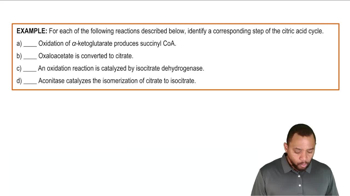Here are the essential concepts you must grasp in order to answer the question correctly.
Fatty Acid Synthesis
Fatty acid synthesis is a metabolic process that involves the formation of fatty acids from acetyl-CoA and malonyl-CoA. This process occurs in the cytoplasm and is catalyzed by a series of enzymes, primarily fatty acid synthase. Each cycle of the synthesis adds two carbon atoms to the growing fatty acid chain, utilizing one acetyl-CoA and one malonyl-CoA per cycle.
Recommended video:
Acetyl-CoA and Malonyl-CoA
Acetyl-CoA is a key molecule in metabolism, serving as a building block for fatty acid synthesis and energy production. Malonyl-CoA, derived from acetyl-CoA, acts as a two-carbon donor in the elongation of fatty acids. Understanding the roles of these two molecules is crucial for calculating the number of acetyl-CoA molecules required for synthesizing longer-chain fatty acids.
Recommended video:
Phase B - Succinyl CoA Formation Example 2
Decarboxylation and CO₂ Release
During fatty acid synthesis, decarboxylation reactions occur, where carbon dioxide (CO₂) is released. Each malonyl-CoA contributes a two-carbon unit to the fatty acid chain, releasing one molecule of CO₂ in the process. This release is significant for understanding the overall stoichiometry of the synthesis pathway, particularly when calculating the total CO₂ produced for a specific fatty acid length.
Recommended video:
Naming Dicarboxylic Acids Concept 3
 Verified step by step guidance
Verified step by step guidance Verified Solution
Verified Solution



 1:3m
1:3m